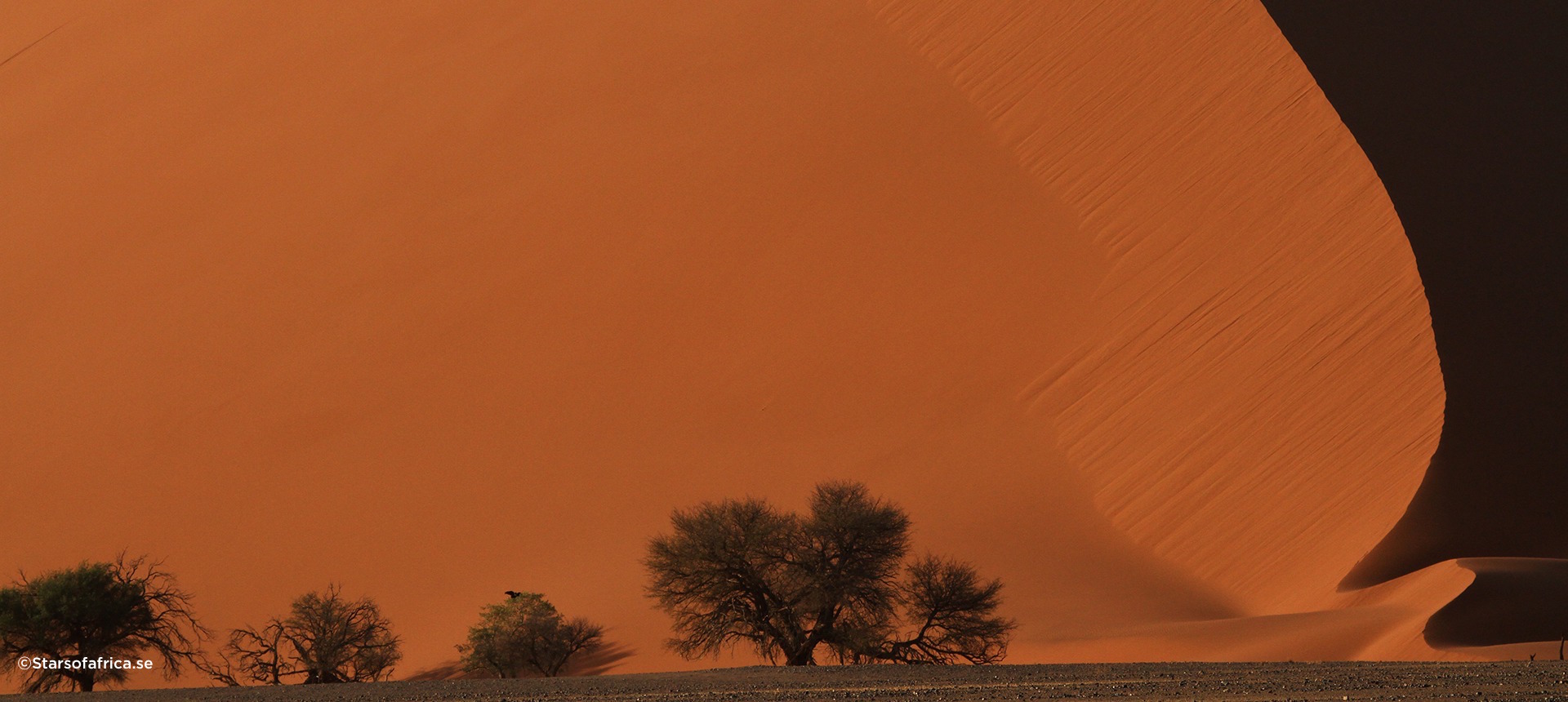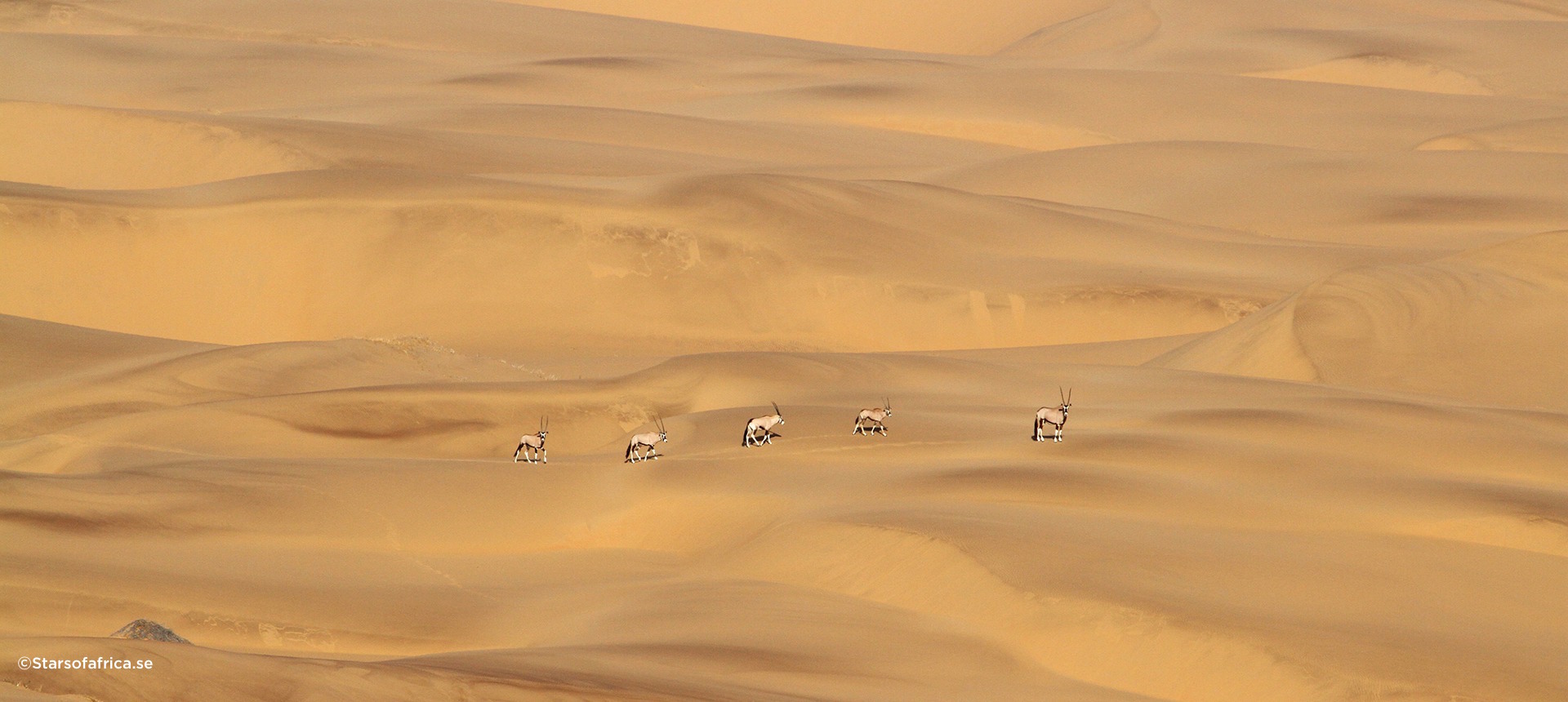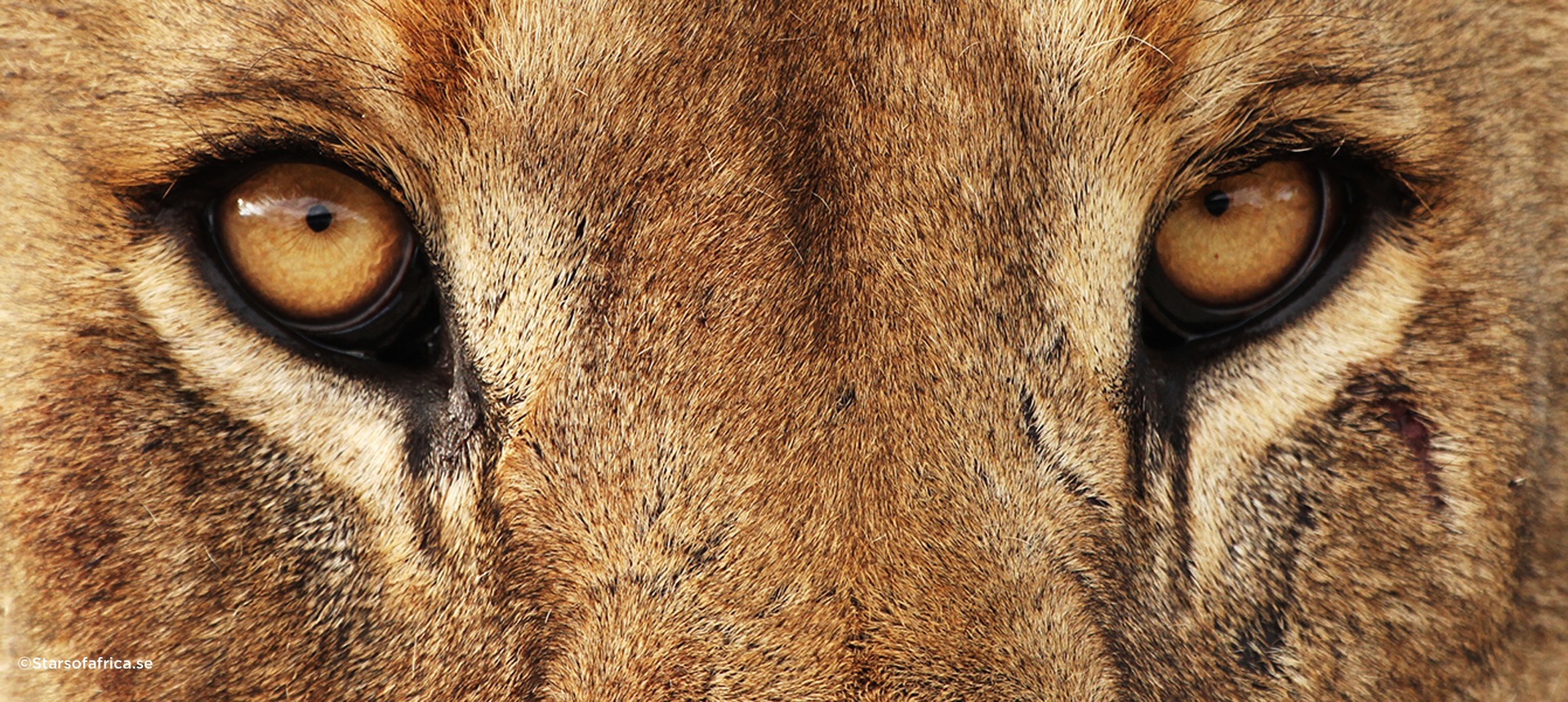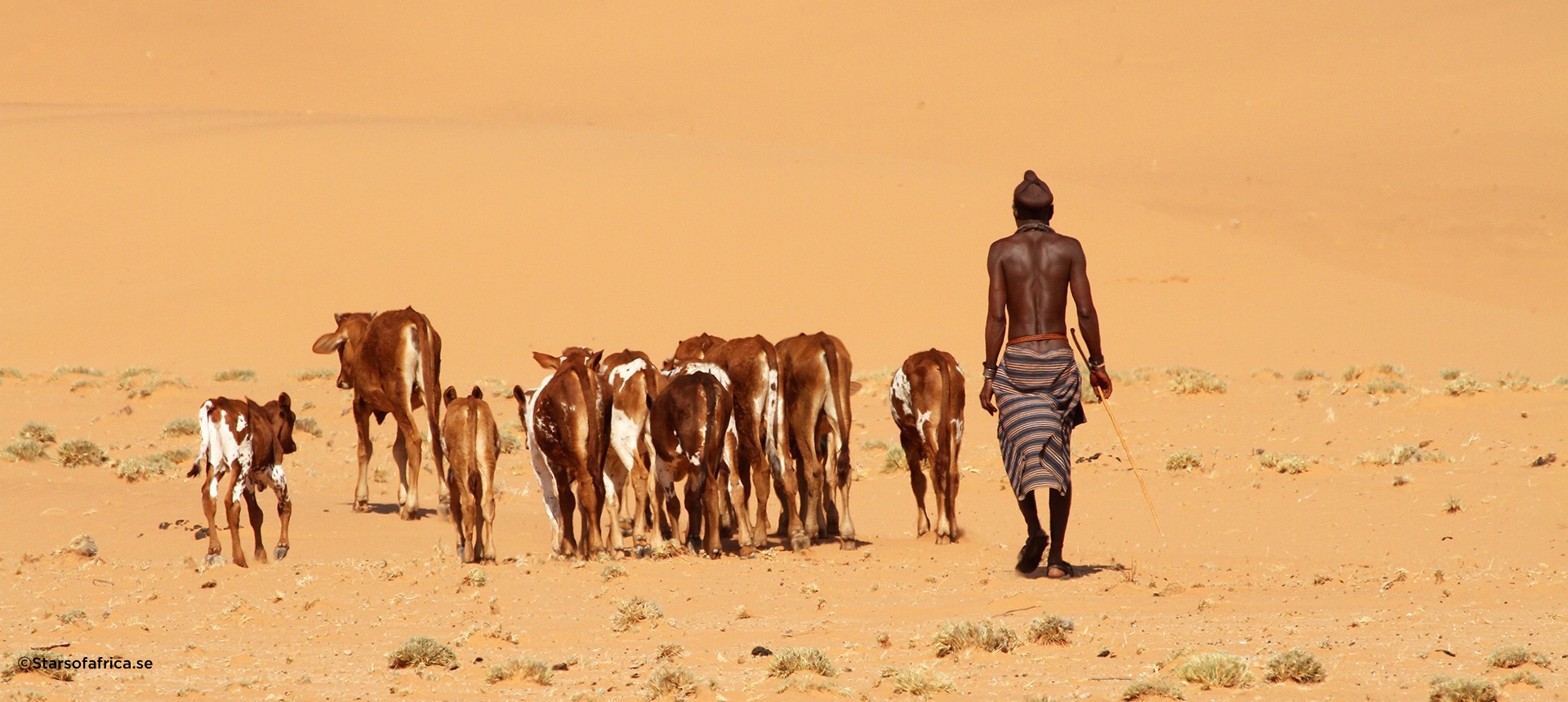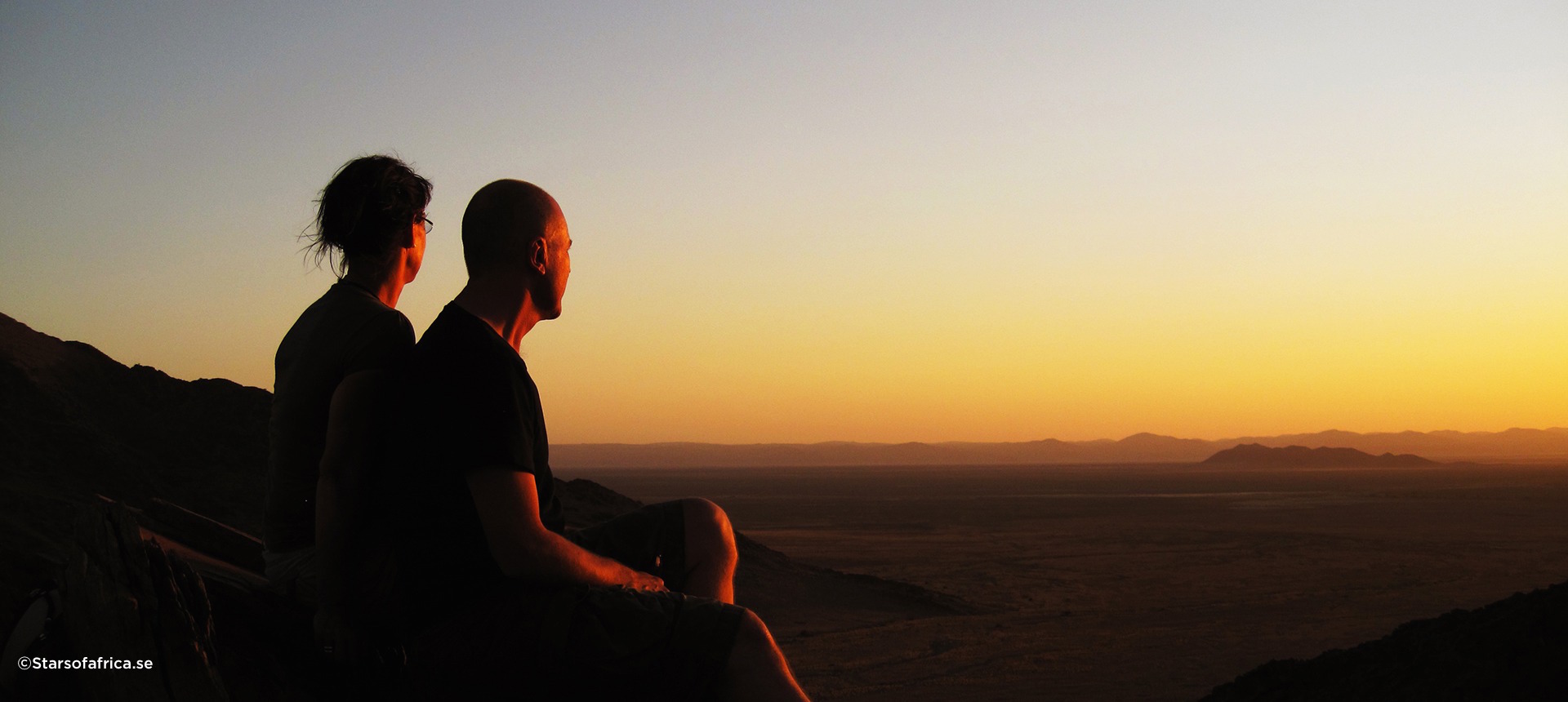NAMIBIA
STIRS THE SOUL AND MOVES THE HEART
Space sets Namibia apart. The joy derived from the stillness, the beauty, the solitude and the sheer uniqueness stirs the soul and moves the heart. Namibia is a vast desert country of wilderness, sunshine, rolling sand dunes and rugged epic landscapes.
One of the most enchanting and remarkable corners of the Earth, Namibia is characterized by immense open spaces, breathtaking scenery and spectacular contrasts – the ocean, sand dunes, mountains and deserts. With a relaxed ambience and the freedom to explore, it offers privacy to enjoy exotic experiences in a panoramic setting. This is a country where both flora and fauna have adapted to survive and thrive in the ruggedness of the Namibian landscape.
Namibia straddles two of the world’s greatest deserts. The Namib is the oldest desert on earth, with its sea of red sand stretching along the entire Atlantic coastline. The Kalahari, in the eastern interior of Namibia, is a vast savannah with sparse vegetation that sprawls across the border into neighboring countries.
Namibia is a photographer’s dream that has rapidly become a well-known safari destination with a difference. It is famed for remote and intimate lodges, the diversity of its stunning wide-angle landscapes, wildlife specially adapted to a desert existence, and for its indigenous people.
Namibia shares borders with Zambia and Angola to the north, Botswana and Zimbabwe to the east, and South Africa to the south. It is a large, sparsely populated country with 2.3 million people, and is almost four times the size of Great Britain. The country gained independence from South Africa in 1990, emerging from the specter of apartheid with a true sense of unity in diversity. Eleven ethnic groups joined forces to become Namibia. As a new nation, it began shaping its future in an understated, but groundbreaking manner. For example, it added provisions for environmental protection and the conservation of natural resources into its constitution – the first nation to do so. Despite its small population, Namibia is home to a wide range of indigenous languages, with English, however, being the country’s official language.
For thousands of years, people of varying lineages, including San Bushmen, Bantu herdsmen, Himba, Herero and Nama tribes, have called this rugged land home. The ancient history of this country is depicted in its rock paintings, some dating as far back as 25,000 B.C.
Where to stay
WINDHOEK
Namibia’s small, German-influenced capital, Windhoek, serves as the country’s geographical heart and commercial hub. Set among low-lying hills at an elevation of around 1,660 meters, or 5,600 feet above sea level, the capital enjoys dry, clean air and a healthy highland climate. Windhoek is an ideal base from which to depart on exciting adventures to explore the rest of the country. With a population of only about 325,000, it is an extremely small capital by global standards. The city centre is characterized by a proliferation of German buildings, a lasting reminder of Namibia’s early colonial history, with streets filled with people representing a wonderful array of colorful African cultures. Here, the sun shines almost every day of the year and the weather is reliably warm to mild, even in mid winter.
NAMIB-NAUKLUFT NATIONAL PARK
Namib-Naukluft National Park is one of the largest national parks in Africa, protecting the Namib Desert, one of the oldest and most stunning deserts on earth. The word ‘Namib’ means open space and it was from this word that the country derived its name Namibia. This is truly a land of wide-open spaces and solitude. The main attraction of the southern region is the spectacular Sossusvlei, a place of dramatically contrasting features. Dry yellow grass is layered against the curves of red sand dunes under beautiful blue skies, with ghost-like petrified trees standing erect against the background in Dead Vlei. There is so little moisture here that when the trees die they cannot decay. Many of the dead trees still standing today died hundreds of years ago.
Majestic star-shaped dunes with curvaceous lines are some of the tallest and most spectacular dunes in the world, rising in places to more than 300 meters/1,000 feet above the desert floor. The winds that bring the fog rolling in from the Atlantic are responsible for creating the park’s towering dunes, whose burnt orange coloring is a sign of their age. The orange coloring develops over time as the iron in the sand oxidizes, like rusty metal. The older the dunes, the darker the shade of orange. The sand in the Namib Desert shifts down the Orange River from the Kalahari Desert in Botswana, and is believed to be five million years old. Sossusvlei is a place of tranquility and one of a few places on earth that is void of human history, and in that realization lies its transcendent beauty.
KAOKOVELD AND KUNENE REGIONS
Kaokoveld is an area in the remote northwest of Namibia, in the Kunene region, with stunning landscapes ranging from expansive sand dunes to towering mountain peaks, ancient valleys, flood plains scattered with boulders and curious rock formations. This is a vast, varied and incredibly silent part of the country, home to one of the last semi-nomadic peoples on earth; the Himbas. Rivers and steep mountain ranges dissect this region, with passes that seem unconquerable. It is one of the wildest and least populous areas of Namibia.
In the extreme northwest of Namibia lies the hidden Hartmann Valley with its stunning scenery, here one gets a true sense of the enormity of the place, and also of its complete and utter isolation. At the northern end of the Hartmann Valley, flows the beautiful Kunene River, which acts as a natural border between Namibia and Angola. The lush banks of the Kunene stand in stark contrast to the surrounding desert – and are havens for a diverse range of wildlife. The Kunene River, the only permanent source of water in this region, creating a lush oasis, is a winding band of green surrounded by the lunar-like landscape of the Namib Desert that stretches to the Serra Cafema mountain range in the north. The mountain ranges near the Kunene River are rugged and impressive with the highest point being 2,039 meters/6,690 feet above sea level. It seems an oddity that a river runs through this arid landscape, with the only real waterfalls in Namibia along its course.
The Himba people who inhabit this world of incredible mountain scenery are the descendants of the earliest Hereros who migrated into this area in the 16th century. The Himbas are semi-nomadic pastoralists, many of whom still live and dress according to ancient traditions. They live in scattered settlements throughout Kaokoland. The women are especially known for their beauty, enhanced by intricate hairstyles and traditional adornments. A fragrant mixture of red ochre and fat are rubbed all over their bodies, giving them their distinctive rich red appearance. This treatment also acts as protection against the harsh desert climate.
WILDLIFE
Despite its aridness, Namibia is full of magnificent landscapes and exotic wildlife. Its national parks and concession areas have protected its flora and fauna effectively and offer terrific big game sightings, far from the hordes of tourists common to more conventional safari countries. Namibia has been the most successful country in the world at protecting its black rhino population and can boast of having Africa’s largest population of cheetahs. The status of the Namib Desert, as one of the world’s oldest deserts, makes the extraordinary manner in which plants, animals and even human populations have adapted and evolved in order to survive particularly fascinating. There are several species endemic to the region; animals and plants found nowhere else on the planet – such as the famous desert elephants and extraordinary Welwitschia plants, that are considered living fossils capable of living 1,000 years or more. Some individual plants are thought to be over 2,000 years old.
Towards the south-east lies Etosha National Park, a vast national park the size of Switzerland, which is home to a staggering diversity of animals, birds and plant life; 114 mammal species, 340 species of birds, 110 reptile species, 16 amphibian species and, surprisingly, one species of fish. The park is dominated by a massive mineral pan that formed approximately 1,000 million years ago, a vast shallow bowl of silvery sand. During the dry season, tens of thousands of animals converge to drink at the water holes beside this pan. Etosha was designed for visitors to drive themselves around; that’s how most people get here.
PHOTOGRAPHY
Namibia is a desert paradise for photographers that has rapidly become a well-known photo safari destination with a difference; its uniqueness, the stunning diversity of its landscapes, its wildlife, specially adapted to a desert existence, and its indigenous people are what draw photographers from all over the world. Despite its aridity, Namibia is full of magnificent landscapes and exotic wildlife. Wildlife photography includes cheetahs, leopards, and desert-adapted elephants and rhinos in the most stunning of landscapes; endless salt-pans, moonscapes hewn in red rock, and deserts that sweep to the sea. Namibia also offers the rare chance to document the timeless traditions of the San Bushman, the Topnaar, and the fascinating Himba people.
Namibia is very different from all the other countries in Southern Africa. It is one of the least densely populated countries in the world, as a result, there is very little light pollution, offering excellent opportunities for night and star photography.
Some of the most sought after photographic experiences are the highest and oldest sand dunes in Sossusvlei, as the first and last light of the sun draw an ever-changing pattern of shadows on their deep orange slopes. Close by are some of the most graphical trees on Earth, the surreal Quiver trees and dead Camel Thorn trees of Dead Vlei.
CLIMATE
Namibia is a land of clear blue skies and over 300 sunshine days per year. But, just as Namibia is a country of contrasting geography, similar climatic differences apply, depending on location. Generally, Namibia’s climate is very dry and pleasant. The cold Benguela Current keeps the coast cool, moist and free of rain for most of the year, with temperatures maintaining a relatively stable range of 15°C/60°F to 25°C/77°F. Heavy fogs are fairly common at night in the coastal regions.
April – September
This is the dry winter season, which is generally cool, pleasant and clear. Daytime temperatures in the interior range from 18°C/64°F to 25°C/77°F, with temperatures dropping to below freezing and ground frosts being common at night. The winter months are generally dry.
October – November
This period is still considered the dry season, but with higher temperatures, especially in the low-lying, more northern regions.
December – March
The majority of Namibia’s precipitation occurs in the summer when rain showers can be heavy and prolonged in the northern regions. The further south or west, the drier it becomes, with many regions receiving no rainfall at all some years. Average daytime summer temperatures in the interior range from 20°C/68°F to 34°C/93°F. Temperatures above 40°C/104°F are not unusual in the extreme north and south of the country.


